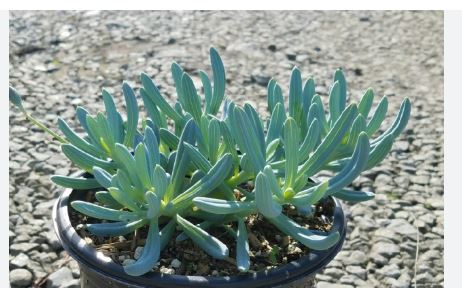
Blue Chalksticks (Curio repens) is a succulent that has garnered attention for its unique aesthetic and ease of care. Botanically, this plant is characterized by its powdery blue, cylindrical leaves that grow in a dense, mat-like formation. These leaves, which can reach up to 2 inches in length, are borne on prostrate stems that root at the nodes as they touch the ground, allowing the plant to spread over time. The stems start off erect but then lie down, contributing to its sprawling habit. In summer to early fall, Blue Chalksticks can produce small, creamy-white flowers in corymb-like clusters, adding a subtle charm to its predominantly foliage-based appeal.
The history of Blue Chalksticks intertwines with its scientific naming and reclassification. Originally known as Senecio serpens, it was later renamed to Curio repens, reflecting a taxonomic shift within the Asteraceae family. This name change also honors its creeping or crawling nature, as “repens” in Latin means “creeping.” Historically, succulents like Blue Chalksticks have been valued for their drought resistance and ornamental qualities, making them popular in both indoor and outdoor settings in Mediterranean-style gardens and xeriscaping.
Native to the Western Cape of South Africa, Blue Chalksticks thrives in the arid, rocky environments of its homeland. This region’s climate, characterized by hot summers and mild, wet winters, has shaped the plant’s adaptations, such as its water-storing leaves and tolerance for poor, well-drained soils. In its native habitat, Blue Chalksticks grows among other succulents and on rocky outcrops, where its blue-green leaves contrast beautifully with the surrounding flora.
Blue Chalksticks can be considered perennial in its ideal climate, where it can live for many years with minimal care. However, in regions where it’s not native, it might be grown as an annual, especially if it’s not overwintered or if the frost is too harsh. With proper care in suitable environments, Blue Chalksticks can be a long-lasting addition to a garden or container collection, potentially living for over a decade under optimal conditions.
When it comes to USDA hardiness zones, Blue Chalksticks is best suited for zones 9b to 12. In these zones, the plant can survive winter temperatures down to about 25°F (-3.9°C), making it a suitable choice for warm, frost-free areas. In cooler climates, it’s often grown as a houseplant or in containers that can be moved indoors during the winter months to protect it from freezing temperatures. This adaptability to different growing conditions, from full sun to partial shade, as long as the soil is well-draining, makes Blue Chalksticks a versatile choice for gardeners looking to add a touch of blue to their landscape or interior spaces.
Blue Chalksticks (Curio repens): Characteristics
- Foliage Color and Texture: The plant features powdery, blue-gray leaves that give it a chalky appearance, hence its common name. The leaves are cylindrical and have a soft, almost velvety texture.
- Leaf Shape and Size: Leaves are long, slender, and tubular, growing up to 2 inches in length. They are arranged in a dense, overlapping manner along the stems.
- Growth Habit: Blue Chalksticks has a prostrate, sprawling growth habit. The stems start upright but soon become trailing, rooting at the nodes to form a mat-like cover.
- Flowering: During summer or early fall, it produces small, creamy-white flowers in clusters. However, the flowers are less prominent compared to its striking foliage.
- Succulent Nature: As a succulent, it stores water in its leaves, making it drought-tolerant and ideal for xeriscaping or low-water gardens.
- Sun Exposure: Prefers full sun to partial shade. In intense sunlight, the blue color deepens, but too much direct sun without acclimation can lead to leaf scorch.
- Soil Requirements: Thrives in well-draining, sandy, or gritty soil. It’s not particular about soil fertility but does not tolerate wet feet, which can lead to root rot.
Blue Chalksticks (Curio repens): Cultivation
- Light Requirements: Blue Chalksticks thrives in bright, indirect sunlight but can tolerate full sun, especially in cooler climates. In hotter regions, some afternoon shade might prevent leaf burn.
- Soil: Use a well-draining cactus or succulent mix. Adding sand or perlite can enhance drainage, mimicking its natural rocky habitat.
- Watering: Water sparingly, allowing the soil to dry out completely between waterings. Overwatering can lead to root rot. During winter, reduce watering even further.
- Temperature: Prefers warm temperatures, ideally between 65-75°F (18-24°C). It’s not frost-tolerant, so in regions with cold winters, it should be brought indoors or protected.
- Humidity: This plant is adapted to low humidity environments and does not require high humidity levels typical of tropical plants.
- Fertilization: Use a balanced, diluted fertilizer formulated for cacti and succulents during the growing season (spring and summer). Fertilize once a month at most, as too much can harm the plant.
- Propagation: Easily propagated from stem cuttings. Simply snip a piece of stem, let it callous over for a few days, then place in soil to root. It can also spread through its own growth by rooting at the nodes.
- Potting: Use shallow pots or containers with drainage holes to prevent water accumulation at the roots. Repotting every couple of years can refresh the soil and accommodate growth.
- Pruning: Prune to control spread or remove any damaged parts. The plant can be shaped or kept more compact if desired.
- Pests: Generally pest-resistant, but watch out for mealybugs and spider mites, especially in indoor conditions. Treat with insecticidal soap or neem oil if necessary.
- Disease: The primary concern is root rot from over-watering or poor drainage. Ensure the potting mix and watering practices allow for good aeration.
- Winter Care: In colder climates, Blue Chalksticks should be overwintered indoors or in a greenhouse. Minimal watering during this period helps prevent rot in the cooler, less active growth phase.